Effective Strategies to Deter Woodpeckers on Your Property
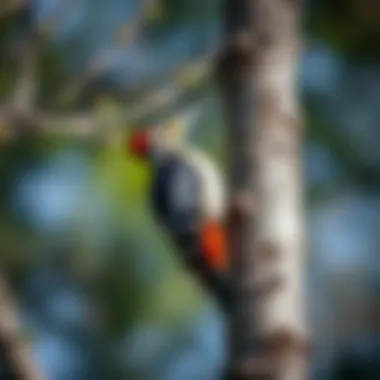
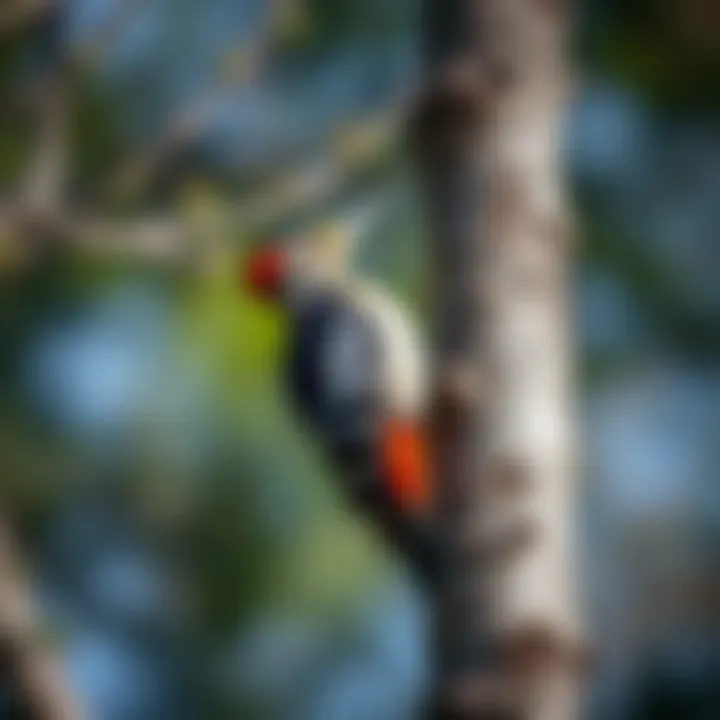
Intro
Woodpeckers are fascinating creatures, often admired for their vibrant colors and unique drumming sounds. However, when their activities encroach upon residential properties, these charming birds can quickly become a nuisance. Many homeowners find themselves confronted with the reality of woodpeckers damaging their homes by pecking at siding, fascia boards, and even wooden decks. Given their knack for creating holes and cavities, it's vital to understand these feathered intruders in order to effectively deter them.
When looking to safeguard your property, the first step lies in recognizing a woodpecker's behavior and identifying any signs of their presence. This not only informs you of their habits but also prepares you to tackle potential damage proactively. In this article, we will delve into practical methods for preventing woodpecker activity, ranging from maintenance tips to natural deterrents. By appreciating both their ecological role and establishing boundaries for our homes, we not only protect our property but also align ourselves with a broader environmental consciousness.
Let’s begin by identifying these birds and the damage they can cause.
Intro to Woodpecker Behavior
Understanding woodpecker behavior sets the stage for all subsequent strategies for prevention and deterrence. Woodpeckers, those drumming acrobats of nature, come with unique habits and preferences that shine a light on why they might take a liking to your home. Recognizing these behaviors is not just a matter of curiosity; it directly informs how to effectively protect your property. Homeowners who grasp these insights can appreciate the balance of respecting wildlife and maintaining the integrity of their dwellings. Woodpeckers may not be malicious, yet the damage they do can be disheartening and costly.
Understanding Woodpecker Species
Different woodpecker species exhibit distinct habits and preferences, which can illuminate why they may become frequent visitors to residential areas. For instance, species like the Downy Woodpecker prefer softer trees, while the Northern Flicker is often found foraging on the ground. Realizing which species is hanging around your property helps formulate tailored strategies. Specialty guides, such as those from Britannica, can provide in-depth information on their diets and nesting habits.
Some common woodpecker species include:
- Hairy Woodpecker: Often mistaken for the Downy, this bird prefers larger trees.
- Red-bellied Woodpecker: Known for their distinctive call and can often be found at feeders.
- Pileated Woodpecker: The largest of the common types, they can cause significant damage due to their size and drilling capabilities.
Why Woodpeckers Choose Your Home
Woodpeckers often choose homes based on a combination of factors like food availability, nesting sites, and even just plain opportunity. Properties with untreated wood, siding, or eaves can seem like a feast to these birds. They look for:
- Food: Wood-boring insects like beetles and larvae are prime targets. If your house is hosting these critters, woodpeckers will come knocking.
- Nesting Opportunities: Older homes or those with wood damage may provide easy nesting cavities. If you've got a decayed area or exposed wood, they might see it as a cozy spot for their young.
- Sound Resonance: Some woodpecker species respond to the echo of their pecking. Your home’s structure could create that appealing drum-like sound, attracting them more.
"Woodpeckers select locations not just for sustenance, but also as part of their social interactions within their species."
By understanding the reasons behind their presence, homeowners can act preemptively. Whether it’s fixing damaged wood or addressing pest infestations, a proactive approach can mitigate potential damage before it gets outta hand. Grasping these behavioral aspects equips you to tailor your property’s defenses effectively.
Identifying Woodpecker Damage
Understanding the signs and the extent of woodpecker damage can save homeowners a headache later on. Acknowledging the problem early can help maintain not only the aesthetics of your property but also its structural integrity. If you notice woodpeckers around, determining the signs of their activity is key to addressing any damage before it escalates.
Signs of Woodpecker Activity
Keep a vigilant eye on your property. Woodpeckers often leave unmistakable clues of their visit. One might notice small holes in wooden surfaces, or perhaps hear them tapping rhythmically. Here are a few signs you can look for:
- Drilling Holes: Check for small, round holes which can be a few millimeters wide. These are often where the birds are excavating for insects.
- Chips and Shavings: Finding wood shavings beneath the trees or on the ground could indicate that woodpeckers are hard at work.
- Pecking Sounds: Listen for the sounds of pecking. This can be intermittent, but such noises often indicate their presence nearby.
- Nesting Signs: In some cases, woodpeckers might peck out cavities for nesting. A closer inspection may reveal larger holes or a more significant amount of shavings.
- Wall Damage: If you notice woodpecker damage on the exterior of your home, it may be time to reassess your property features.
"Being proactive about identifying woodpecker damage helps to address the issue before it gets out of hand."
Types of Damage Caused by Woodpeckers
Woodpeckers don't just tap on trees; they can cause serious issues when they choose your home or property as their canvas. Recognizing the various types of damage can help homeowners prioritize repairs and preventative measures. Some common forms of damage include:
- Wood Rot: Constant pecking can weaken wooden structures. This means doors, siding, eaves, and even window frames could incur damage leading to rot over time.
- Structural Compromise: Holes that go deep into wood can compromise the structural soundness of your home. Ignoring these can lead to more severe repair needs down the line.
- Paint Damage: The incessant pecking can also chip away paint, leading to unsightly areas on the exterior of your home. An unattractive exterior can affect your property value.
- Pest Attraction: Open holes can provide entryways for other pests. This includes termites and ants that may take advantage of the woodpecker's hard work, further compounding your issues.
- Increased Energy Costs: Affected areas in your walls can lead to drafts, causing your heating and cooling systems to work harder, thus increasing energy bills.
In essence, while woodpeckers contribute to the ecosystem, their followings can be detrimental if their activities are not managed properly. Homeowners should be quick to heed these signs and types of damage as integral steps in the broader strategy of deterrence.
For more information about how woodpeckers interact with their environment, visit Wikipedia on Woodpeckers.
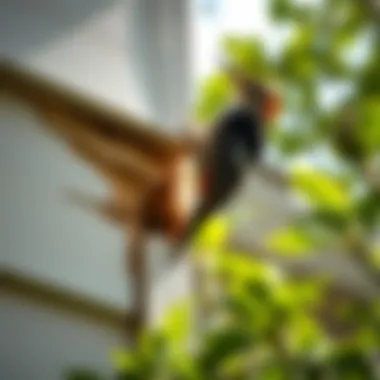
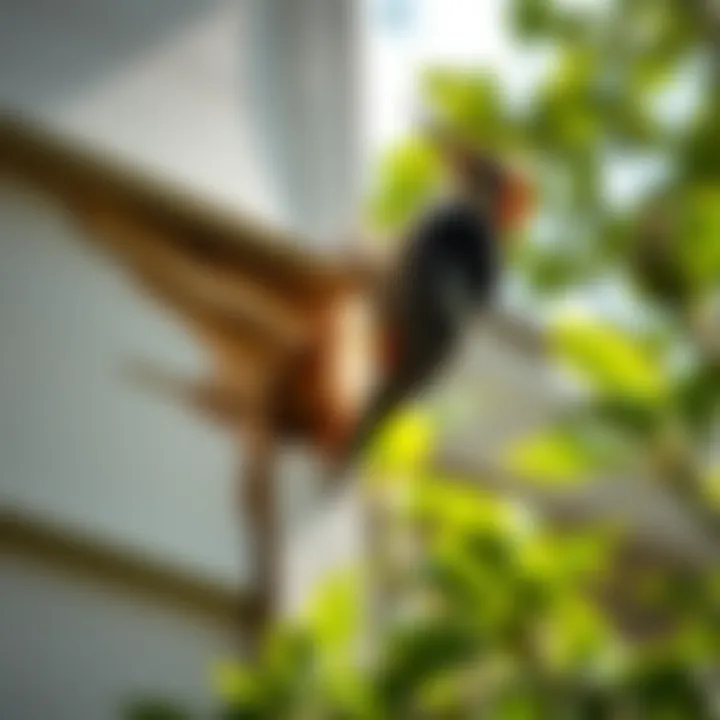
Environmental Modifications
Woodpeckers often gravitate toward residential areas, lured by their essential needs: food, shelter, and nesting sites. Altering the environment can significantly deter these birds and encourage them to seek sustenance elsewhere. Environmental modifications are a crucial part of any long-term strategy to address woodpecker issues. This approach not only protects your home but can also enhance your overall landscape, creating a more vibrant and harmonious environment.
Enhancing Property Features
Making your property less appealing to woodpeckers starts with the features you showcase. Here are a few practical changes to consider:
- Maintain your trees: Prune dead or decaying branches where woodpeckers might forage. Keeping your trees healthy can minimize nesting sites near your home.
- Diversity in vegetation: By planting a diverse array of trees and shrubs, you can distract woodpeckers from targeting your wooden structures. Consider plants that produce berries or seeds that attract other birds, steering attention away from your property.
- Properly seal your wood surfaces: Use a quality sealant on wooden features like decks and fences. This not only protects the wood but makes it less appealing for woodpeckers, as they often drill into untreated wood in search of insects.
Regularly changing aspects of your landscape can have a profound impact on woodpecker behavior, ensuring they find a more inviting habitat outside your property.
Implementing Sound Barriers
Sound is a powerful tool in discouraging woodpecker activity. Here are a couple of effective methods:
- Motion-activated devices: Installing devices that emit sudden bursts of noise can startle woodpeckers. These sounds should ideally mimic natural predation threats, deterring them from coming too close.
- Natural sound barriers: Erecting barriers that dampen noise can make your environment less inviting. Hedges, dense shrubs, or fences absorb sounds and also create a less desirable area for woodpeckers to settle.
A combination of visual and auditory elements can create an unwelcoming atmosphere for these birds. Not only do these modifications serve to mitigate woodpecker activity, but they also support the overall health of your property.
"Creating a less enticing environment through modifications is a proactive way to prevent damage to your home."
By re-imagining the features of your property and employing sound barriers, you not only protect your home from woodpeckers but create a thriving habitat for various bird species. For more ideas on enhancing your landscape and keeping woodpeckers at bay, visit USDA Wildlife Services.
Physical Deterrents
A good way to keep woodpeckers at bay is using physical deterrents. Such measures can stop these noisy birds from making your property their playground. Physical deterrents don’t just target the birds; they also help maintain the structure of your home. It’s all about creating an environment that’s not appealing for woodpeckers and protecting your valuable assets.
Installing Bird Spikes
One quite effective strategy involves installing bird spikes on surfaces where woodpeckers are prone to perch. These spikes are not harmful; they simply make it impossible for birds to land. Think of them like a “no parking” sign for woodpeckers. They’re easy to install and come in various sizes, making it simple to find the right fit for any area.
When considering bird spikes, pay attention to the following points:
- Placement: Ensure spikes are strategically placed in areas of high activity, such as eaves, gutters, or rooftops.
- Material: Look for durable materials like stainless steel or heavy-duty plastic which can withstand harsh weather.
- Length and density: Opt for longer spikes as they can cover more ground. The denser they are, the more effective they will be at deterring woodpeckers.
Installing these spikes could provide a long-term solution without needing constant upkeep.
"Using bird spikes can create an unwelcoming landing zone, nudging woodpeckers to seek alternative nesting spots."
Utilizing Reflective Objects
Another practical method involves the use of reflective objects. Woodpeckers, like many birds, are not fond of shiny surfaces. Hanging reflective items can confuse and ward them off effectively.
Consider these options:
- Old CDs or DVDs: Hanging up these disk-like items can create an array of reflections, especially when the sun hits them just right.
- Foil strips: Strip cut from aluminum foil can sway in the wind, catching the light and creating movement, which is often unsettling for birds.
- Reflective tape: This tape can be attached to building surfaces or hung in various spots outdoors to maximize visibility.
While reflective objects may seem simple, their impact can be substantial. Remember to reposition them occasionally to maximize their effectiveness, as woodpeckers may eventually become accustomed to static objects. These physical deterrents are not a foolproof method but rather part of a well-rounded strategy to deter woodpeckers that may save your home from unwanted pecking.
Chemical Deterrents
When it comes to keeping woodpeckers at bay, the use of chemical deterrents can be a key piece of the puzzle. These solutions work by either making the environment less appealing to woodpeckers or introducing scents that they find uninviting. It’s important to choose the right products, as not all repellents are created equal, and effectiveness can vary widely.
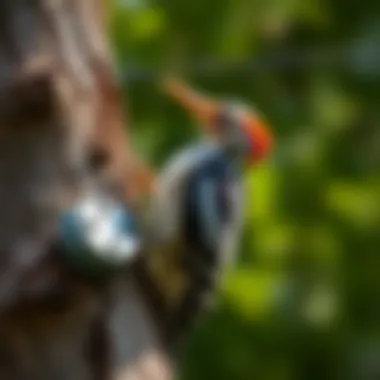
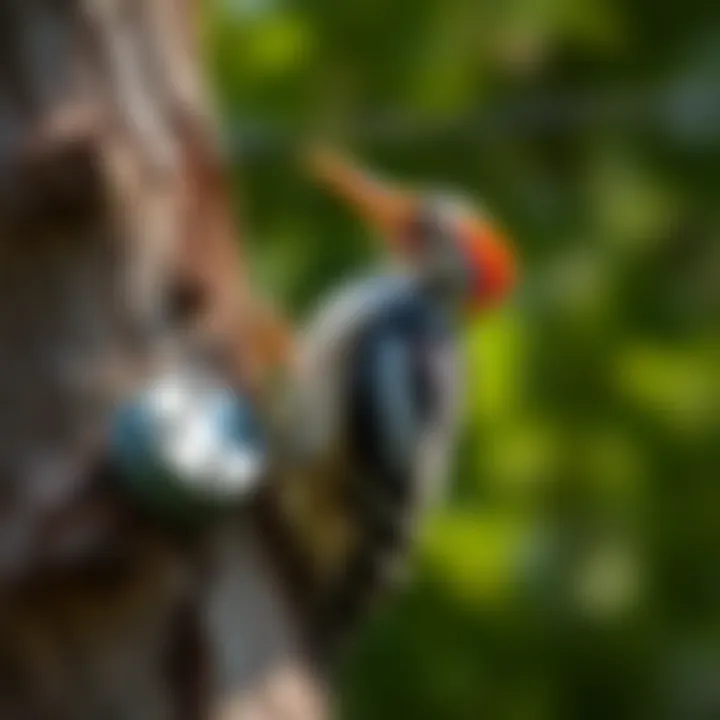
Commercial Repellents
Various commercial repellents are available on the market, carefully designed to deter woodpeckers effectively. These products often utilize scents or tastes that are offensive to these birds. Many rely on the natural instincts of woodpeckers to evade unpleasant surprises. Here’s a breakdown of some popular options:
- Taste aversion sprays: These are often made from hot pepper extracts or other spicy ingredients that woodpeckers dislike.
- Scent-based products: Repellents that emit odors, like peppermint or citrus, can help keep woodpeckers away. However, these scents need to be reapplied periodically, especially after rain.
- Gel-based repellents: A good example is Bird Stop Gel, which creates a sticky surface that birds find uncomfortable.
Before applying any of these chemicals, consider the surrounding environment. It's crucial to be mindful of other wildlife, pets, and even children who might come into contact with such substances.
Natural Repellent Solutions
For those who prefer a more organic approach, natural repellents can be just as effective without introducing harsh chemicals into your environment. Here are some ideas:
- Peppermint oil: Mixing water with peppermint essential oil in a spray bottle can create an unpleasant scent for woodpeckers while being pleasant for humans.
- Cayenne pepper and water: A DIY solution that combines ground cayenne pepper with water to create a spray. It’s spicy enough to deter woodpeckers but harmless to other wildlife.
- Vinegar: Spraying a mix of vinegar in areas woodpeckers frequent can help to dissuade them, as the pungent smell is often unwelcoming.
Implementing these natural strategies offers peace of mind, knowing that you’re not exposing your property or the surrounding ecosystem to harsh chemicals.
Using chemical and natural repellents in tandem can provide a multi-faceted approach to deter woodpeckers while navigating various environmental considerations.
Behavioral Modifications
Behavioral modifications play a crucial role in managing woodpecker activity on residential properties. Understanding their habits and adapting our surroundings accordingly can significantly lessen the likelihood of these birds causing damage. By taking a proactive approach, homeowners can discourage woodpeckers without resorting to aggressive measures.
Understanding Feeding Patterns
Woodpeckers have specific feeding habits that are often tied to the time of year and the availability of food. Typically, they target trees and wooden structures to find insects, particularly ants and beetles. This is important to know, as it helps in devising strategies that can make your home less appealing to them.
- Identify Food Sources: Observe the areas where woodpeckers frequently gather. If your property has trees infested with pests, consider treating them with natural pesticides. Cleaning up any decaying wood or stumps nearby can also make a big difference.
- Diverse Feeding Options: If you enjoy watching birds, consider setting up bird feeders filled with seeds that are less attractive to woodpeckers. For instance, finch feeders or platforms with mixed seeds can draw away their attention.
- Regular Maintenance: Regularly inspect your home for signs of insect infestation. Not only will this protect your property, but it will also reduce the woodpeckers’ interest in pecking.
Understanding these feeding patterns allows you to anticipate woodpecker behavior and respond effectively, keeping your home safe from damage.
Timing Strategies for Bird Activity
Woodpeckers often have particular times when they are more active. Most of their pecking occurs during early mornings and late afternoons. By aligning your preventative measures with these peak hours, homeowners can work to deter them more effectively.
- Early Morning Routine: If you notice woodpeckers visiting your place more during the mornings, it might be beneficial to make some noise or play a recording of bird distress calls during these hours to disrupt their activities.
- Observation: Keeping a log of woodpecker sightings can help you identify patterns in their behavior related to the time of year or specific weather conditions. Understanding when these birds become more active can inform your deterrent strategies.
- Adjusting Habits: If it’s a nesting season, limit outdoor activities if you notice them becoming frequent. Woodpeckers are less likely to remain on your property if they sense regular disruption during critical times.
By using timing strategies effectively, you can shift woodpeckers’ behaviors and limit their impact on your property. Making these behavioral modifications means you’re not just reacting, but actively changing how these birds engage with your space.
By understanding and harnessing the natural behaviors of woodpeckers, homeowners can foster a symbiotic relationship with nature while protecting their property.
Professional Help
Dealing with woodpeckers can be a real pain in the neck for many homeowners. While various strategies can be employed to deter these birds, sometimes enlisting professional help becomes a necessity. This section explores why professionals play a crucial role in tackling woodpecker issues effectively, and how to select the right specialists for your needs.
When to Consult an Expert
It's essential to know when to seek out professional assistance. If you're noticing persistent woodpecker activity, it might be time to call in the pros. Here are some key indicators that suggest you should consider consulting an expert:
- Significant Damage: If the woodpeckers have caused extensive damage to your property—like chipping away at your siding or creating large holes—it's wise to consult a professional. Repairing this damage can be complicated and costly, so early intervention is critical.
- Ineffective DIY Methods: After trying various deterrents with no success, you may feel like you’re banging your head against a wall. If your own efforts—like reflective objects or sound deterrents—aren’t working for you, it’s time to call in someone who knows the ins and outs of pest control.
- Health Risks: Woodpeckers can sometimes transmit diseases or introduce other pests, so if there's a chance that your health could be at stake, getting professional help makes sense.
Consider this:
"An ounce of prevention is worth a pound of cure."


Waiting too long can complicate matters further, leading to more severe damage to your property. So, keeping an eye on signs of woodpecker activity is crucial.
Choosing a Qualified Pest Control Specialist
When the time does arrive to find a pest control expert, it's important to pick a qualified individual or company that understands the nuances of woodpecker behavior and control. Here are some factors to consider:
- Experience and Expertise: Look for a specialist who has experience specifically dealing with woodpeckers. Their background should not just be general pest control but should include knowledge about birds and avian behavior.
- Licensing and Certifications: It's crucial that the pest control professional you choose is licensed and certified. This not only guarantees that they are trained but also ensures that they understand and adhere to local wildlife regulations.
- Customized Approaches: An excellent pest control expert won't use a one-size-fits-all solution. Instead, they should be willing to assess your specific situation, including the type of woodpecker involved and the extent of the damage caused, to devise a tailored approach.
- Techniques Used: Inquire about the techniques and tools the specialist plans to use. You'll want to ensure that they utilize humane and sustainable methods to deter the woodpeckers rather than harmful chemicals or traps.
- Reviews and Referrals: Don't underestimate the power of word-of-mouth. Ask friends, family, or even neighbors if they have recommendations. Online reviews can also provide insight into a company's effectiveness and customer service.
Long-term Prevention Strategies
Long-term prevention strategies form the backbone of an effective approach to managing woodpecker presence around your home. Implementing these strategies not only reduces the chances of woodpeckers making themselves at home on your property but also fosters an environment where such issues are nipped in the bud. Homeowners need to consider several layers of actions and adjustments involving environmental management and continuous monitoring.
Taking a proactive stance is crucial. For instance, regular maintenance of your house can discourage woodpeckers from choosing it as a target. Damaged areas of siding or decaying wood on the exterior can be inviting to these birds. Addressing these issues promptly will help maintain your home's integrity and diminish the appeal for woodpeckers seeking food or nesting locations.
Furthermore, fostering an environment that supports local wildlife, without being overly attractive to woodpeckers, is important. Native plants can be encouraged around your property, as these can help sustain many bird species that might compete with woodpeckers. This strategic planting could create a balanced ecosystem right in your backyard.
With long-term strategies, the benefits cascade. Not only could it eliminate current issues, but the reduced likelihood of future woodpecker visits enhances home preservation. Homeowners can rest easy knowing they’ve taken significant steps towards protecting their investments.
"An ounce of prevention is worth a pound of cure," and this rings especially true when it comes to managing woodpecker activity.
Ongoing Monitoring Techniques
Ongoing monitoring is a pivotal component in your long-term strategy against woodpeckers. Regularly observing your property can lead to early detection of woodpecker activity before it escalates into an expensive problem. Keep an eye out for telltale signs like pecking noises or unusual patterns on trees and siding.
In addition to casual observations, set up a routine inspection schedule. Here are a few steps to consider:
- Weekly Checks: Look over the exterior of your home and surrounding trees at least once a week for fresh signs of pecking.
- Record Keeping: Maintain a journal or use a simple spreadsheet to note the dates and details of any sightings or damage detected. This could aid in spotting patterns over time.
- Technology Use: Consider installing motion-activated cameras to monitor frequent areas if you notice persistent woodpecker activity. This not only helps with monitoring but also tries to deter them with sudden movements.
By consistently keeping tabs on your environment, you’ll be able to act quickly, saving yourself time and money down the line.
Community Awareness and Involvement
Engaging your local community can greatly amplify individual efforts to deter woodpeckers from residential areas. Educating neighbors about the need for woodpecker deterrence not only aligns efforts but also creates a more sustainable approach that benefits everyone.
Here are some suggestions to foster awareness in your community:
- Organize Educational Workshops: Host or attend local workshops aimed at teaching homeowners about woodpecker behavior and effective deterrence techniques.
- Social Media Groups: Create or join community groups, perhaps on platforms like Facebook or Reddit, where residents can share experiences, tips, and support each other in managing local wildlife issues.
- Local Wildlife Officials: Collaborate with local wildlife authorities or conservation organizations. They can provide resources or training sessions that educate residents on the ecological importance of woodpeckers while informing them of strategies to coexist peacefully.
Encouraging community involvement fosters a united front. When neighbors are invested, it creates ripple effects that can lead to better ecosystem management while keeping woodpecker populations in check. With shared knowledge and responsibility, residential areas can thrive free from the nuisances of these persistent birds.
End
In wrapping up our discussion on deterring woodpeckers, it's clear that understanding both their behaviors and the ways to effectively minimize their impact is crucial for homeowners. Woodpeckers may be fascinating creatures, but when they choose your home as their canvas, it can lead to significant issues. This article emphasizes the importance of employing a well-rounded approach to manage their presence, integrating various strategies to create an unwelcoming environment for them.
Review of Effective Strategies
When it comes to practical methods for protecting your property, the strategies discussed range widely. Here’s a refresher of key tactics:
- Physical Deterrents: Installation of bird spikes or netting helps prevent roosting and nesting.
- Environmental Changes: Modifying your landscape to make it less inviting, such as trimming trees or removing food sources, plays a vital role.
- Sound Barriers: Employing noise-making devices or reflective objects serves to intimidate these birds effectively.
- Chemical and Natural Repellents: Utilizing both commercial products and natural solutions like spicy mixtures can deter woodpecker activity effectively.
The effectiveness of these strategies is not merely in their individual mechanisms; rather, it is about how they complement each other to form a comprehensive defense against woodpecker damage.
Maintaining a Balanced Approach
While deterring woodpeckers, it’s also important to appreciate their role in the ecosystem. They contribute by controlling pest populations and helping tree health. Therefore, a balanced approach is essential. Eliminating their presence completely isn’t the goal; rather, you want to create an atmosphere that discourages them from damaging your home while allowing them to perform their natural functions elsewhere.
The emphasis should lie in monitoring the effectiveness of the strategies you implement and adjusting them as necessary. Keeping aware of their behavior and adapting accordingly allows homeowners not just to keep their properties safe but also to respect the broader nature in which these birds exist.
In summary, remember that a successful fight against woodpecker aggression is not just about annoyance, but also about holistic appreciation of nature. Thankfully, informing ourselves and making mindful adjustments can lead to peaceful cohabitation with these industrious birds. For further insight into avian behavior and management, resources such as Wikipedia and Britannica can provide additional depth.



